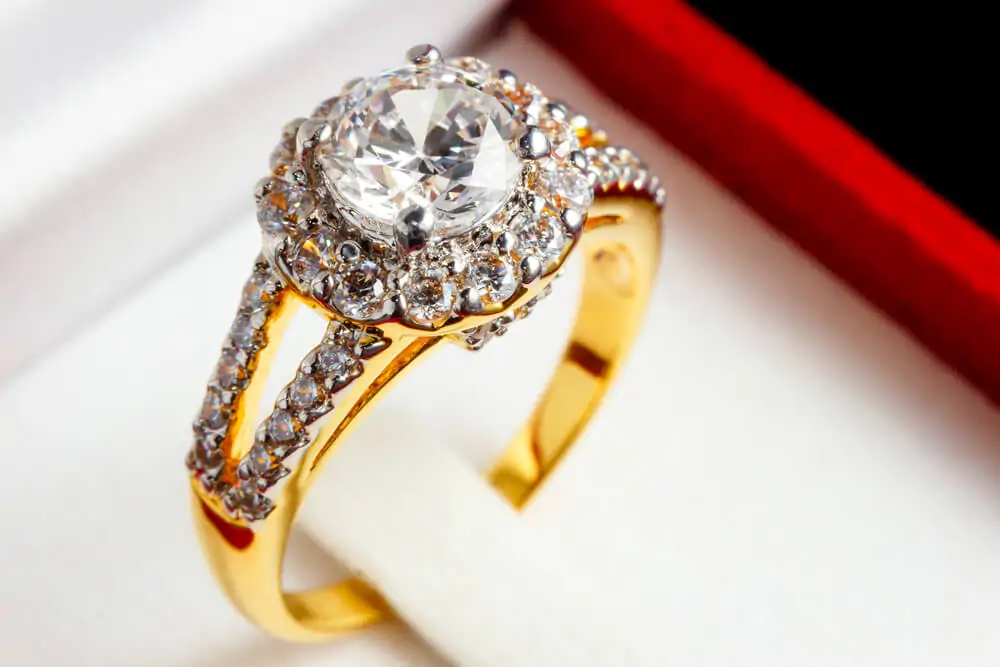
Table of Contents
As Jewelry Shopping Guide editors, we write about things that we love and we think you’ll like too. We often have affiliate partnerships, and may generate some revenue from these links at no cost to you.
Finding the right engagement ring comes down to making seemingly endless decisions! And one of the most important decisions involves selecting the setting for your ring. Once you have chosen you’re ring setting, the entire process becomes easier.
But with the number of options available, how do you pick the right ring setting? Each has its pros and cons and in order to choose the right setting for you, you’ll have to consider your style, preferences and lifestyle, among other things.
For inspiration as to what sort of rings are trending, check out customers’ rings on the Inspiration Gallery of James Allen and the Recently Purchased Engagement Rings on Blue Nile.
To help you in the engagement ring setting selection process, we’ve outlined the most popular ring settings and styles below, including their pros and cons along with examples and images.
1- Prong Setting / Solitaire
Prong settings are most people’s go to choice when it comes to their engagement ring. It consists of one solitary centerstone held in place by metal pins of the prong. For sharp edges, v-shaped prongs are often utilized, to protect the stone from chipping and breaking. V-tipped prongs are most commonly used for pear and marquise shaped diamonds.
Most prong settings consist of 4 to 6 prongs. If more prongs are used, the stone is given more protection and the pins around the stone accentuate its shape. However, the visibility of the stone will be reduced due to the increase in metal. When selecting a prong setting, you’ll have to consider the security of the stone and the beauty of the ring – usually it’s a trade-off between the two.
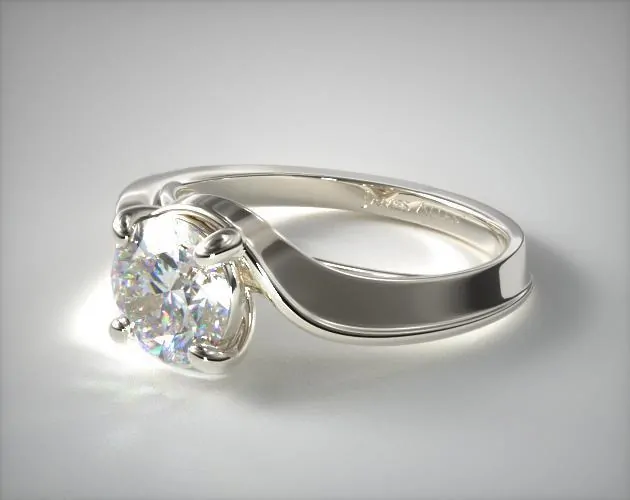
What We Like About It
- Prong settings emphasize the diamond, giving it prominence
- The diamond often appears larger and to full advantage, especially if set against a thin, tapering band
- There is high light reflection and visibility of the diamond
- It’s the most iconic style for engagement rings
What We Don’t Like
- The prongs can catch on everyday objects such as clothes or hair, which can damage the ring and the gemstone
- For those with active lifestyles, the prong setting may not offer sufficient protection
- As the prongs wear thin and get damaged, the diamond is in danger of falling out
Check out more prong settings here
2- The Tiffany Setting
The most popular engagement ring style in the world, the Tiffany setting was created and trademarked by Tiffany & Co in 1886. While most gemstones at the time were set in bezels or low on the band with lots of embellishment, Tiffany was the first to use the prong setting with the aim of displaying more of the diamond and less metal, bringing ring styles into the modern era.
The Tiffany setting consists of 6 equidistant prongs with a specifically engineered collet and the diamond raised high on top of the band. While you can find 6-pronged engagement rings at most jewelry stores now, the original Tiffany ring comes from Tiffany & Co. It is generally seen as the world’s favorite engagement ring setting!
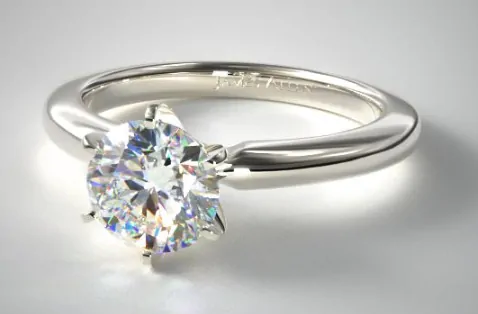
What We Like About It
- Good balance of safety and beauty for a prong setting
- The diamond is held high above the band, allowing for more light reflection and greater sparkle
- The diamond appears large and prominent
- Designed to utilize the least amount of metal obstructing the diamond
- Most popular engagement ring style of all time
- Fashionable and sophisticated, it is a minimalist’s dream ring
What We Don’t Like
- As with all prong settings, the Tiffany setting can snag on everyday objects
- The prongs may wear out and the diamonds may dislodge over time
- There is a greater chance of the diamond getting damaged due to bumps and knocks
3- The Bezel Setting
The bezel setting consists of a strip of metal that is wrapped around the gemstone, holding it securely in place. Bezels are perfect for people with active lifestyles who use their hands a lot. Many people in professions such as nursing prefer bezel settings as it is easier to maintain with their lifestyles.
There are two main types of bezel settings:
Full Bezel Setting: Here the metal wraps the stone’s entire circumference. While this is one of the safest setting options out there, it may not suit someone who wishes the stone to be more prominent.
Partial Bezel Setting: This setting leaves the sides of the stone uncovered which means the stone is more visible but not as secure as the full bezel.
Bezel settings are custom made to fit the stone and requires skilled craftsmanship to accurately secure the stone in the setting.
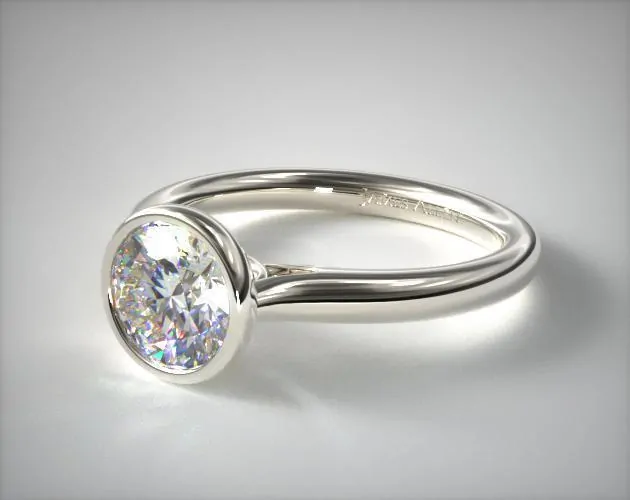
What We Like About It
- Bezels keep the gemstone secure and protected, minimizing damage
- Perfect for people with active lifestyles or those who use their hands a lot in their line of work
- Flaws along the sides and edges of the diamonds can be hidden by the bezel setting
- A classic and timeless design
- Has a sophisticated and fashionable appearance
What We Don’t Like
- It’s more expensive than most other settings as it uses more metal and requires greater skill to craft
- The gemstone is less visible and can look smaller, as the emphasis is on the metal as much as the stone
- Reduces light reflection and sparkle in the diamond
- Can be difficult to clean and maintain, as dirt can get lodged in the rim of the bezel and the undersides
- Can be difficult to resize and requires high level of skill from the jeweler
4- The Tension Setting
This is a relatively new ring setting, created in the 1960s. It is modern and sleek in design and, like the Tiffany setting, is a ground-breaking design that allows for maximum light reflection.
The name itself indicates what type of setting this is. Here, the metal of the ring is positioned in such a way as to use tension or pressure between the two ends of the band to hold the stone securely in place. If you think about it, it is like picking up a bead with tweezers. The right pressure and the right angle must be achieved and maintained to squeeze the bead and keep it from falling. While it may appear that the gemstone is simply floating in air, held lightly by the bands, in reality there are hidden grooves that the stone is fixed into for added protection.
Tension bands are trickier to create as they require exacting precision and workmanship.
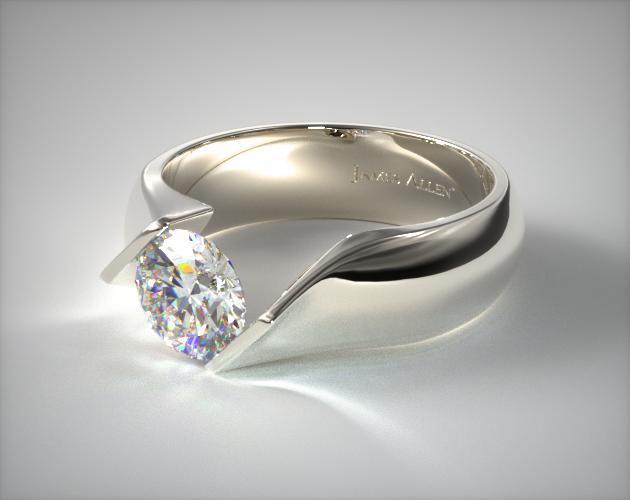
What We Like About It
- It’s unique and intriguing and definitely a talking point
- The diamond is seen to full advantage from all angles
- Light can reflect of the diamond from all angles, creating high brilliance and maximum sparkle
- Easy to clean and maintain
What We Don’t Like
- The design entails higher cost as molding the band to the perfect dimension requires expert artisan skills
- Not as secure as some other settings and there is danger of the stone being knocked out
- The gemstone may appear smaller as the band holding it is often thick
- Difficult to resize
5- The Halo Setting
The halo style is one of the most popular designs for engagement rings. Here, the centerstone is surrounded by smaller diamonds or gemstones to create a halo. This adds sparkle to the center stone and enhances its brilliance, which is why a halo setting is ideal for gemstones that have subdued brilliance, such as sapphires and rubies.
In addition to the sparkle, a halo setting also makes the centerstone appear larger than it is. You can choose a smaller diamond for the center of the stone and add a halo to make the stone appear large. Because diamond prices increase exponentially with the carat weight of the stone, buying a number of smaller diamonds is generally more cost-effective than opting for one large diamond.
Halos are also a great way to add color and contrast to your ring as you can use different types of gemstone pairings for your design. Adding a double halo will further reduce the need for a large center stone while accentuating brilliance and sparkle.
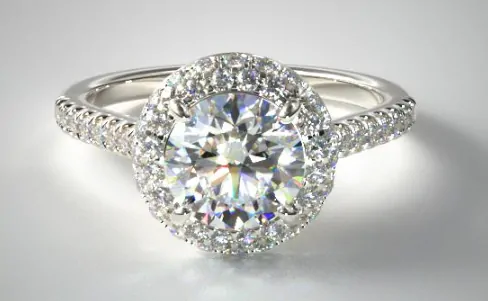
What We Like About It
- The center stone’s brilliance is accentuated by the halo of smaller diamonds
- Overall brilliance of the ring is increased
- Smaller diamonds are cheaper than a single large stone
- The center stone appears larger due to the halo
- You can choose different gemstone pairings for a colorful ring
- Protects the center stone from bumps and rough exposure
What We Don’t Like
- Halo rings are more difficult to maintain and keep clean
- Some stones in the halo may get dislodged over time
6- The Cluster Setting
Similar to the halo, the cluster setting is also designed using several stones crowded together to form a cluster, taking the place of the center stone. You can choose similar sized stones crafted together to create the illusion of one big stone. The cluster setting is an excellent way to mimic the appearance of a large diamond by using a number of smaller ones. As with the halo, the cluster setting is more affordable than a single diamond of the same size.
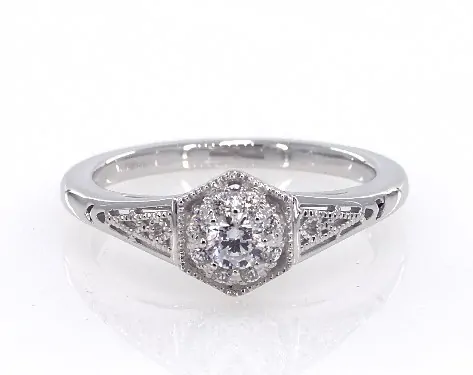
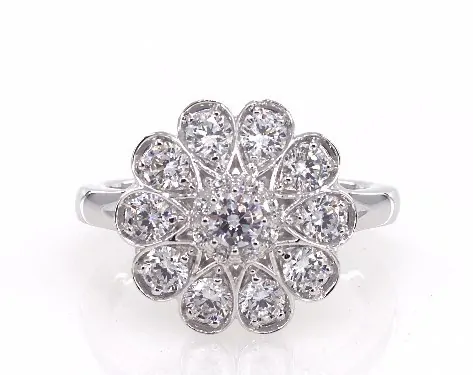
What We Like About It
- Small stones clustered together can create the illusion of a bigger diamond
- The price of smaller stones is cheaper
- The many angles and light reflection creates heightened sparkle
- Added texture and dimension to the ring’s appearance
What We Don’t Like
- Cluster settings can be difficult to maintain and clean due to the grooves and crevices in the design
- Stones can get loose and fall out over time
7- The Cathedral Setting
The cathedral setting is a way of mounting the center stone to give it prominence and make it the focal point of the ring. In this setting, the stone is mounted high above the ring and has an imposing, important appearance like a towering cathedral. At least, that’s how we see it!
The center stone is usually held up high with prongs or in a bezel setting by graceful arches of metal connected to the shank. It is these arches that make the cathedral setting so stunning and elegant. The stone, especially when it’s a diamond, is magnified and appears large and prominent.
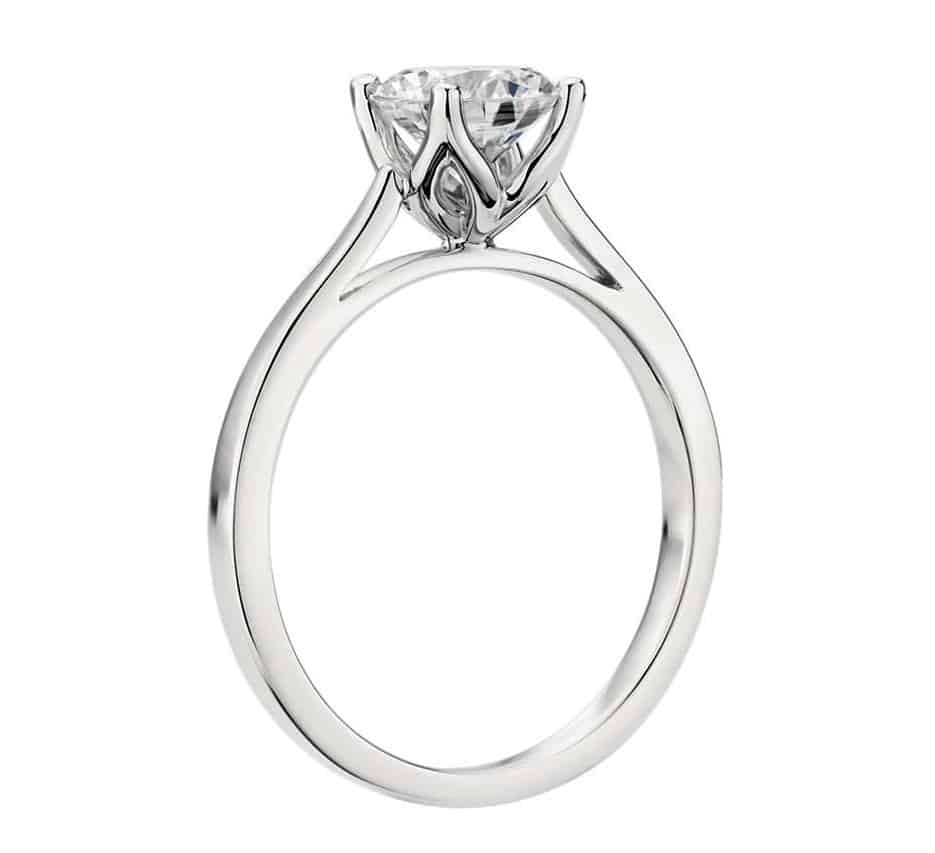
What We Like About It
- The center stone can is emphasized and can appear larger
- Graceful, elegant and unique design
- Elevates the diamond above the band making it the focal point
- The stone is held securely in the setting and supported by the arches
What We Don’t Like
- The stone is more likely to be bumped and knocked due to its elevation
- The gemstone can get damaged due to exposure
- The setting can catch on objects, damaging the prongs and stone
- Cleaning the setting can be time-consuming due to crevices
8- The Channel Setting
The channel setting consists of a series of identical diamonds set all around the circle of the ring within a grooved channel carved into the band. The diamonds are set flush against the metal, keeping them safe. Half-channel settings are also popular, with the row of diamonds only going around half the ring.
However, with the channel setting, cleaning the stones may pose difficulty as they are embedded into the channel. Also, many vendors don’t offer resizing options for eternity settings as this could damage or deform the channel.
When there is no center stone and the row of diamonds goes around the entire circumference of the ring, the channel setting is known as an Eternity band, which is especially popular as a wedding ring option.
The ring below depicts a half-channel setting.
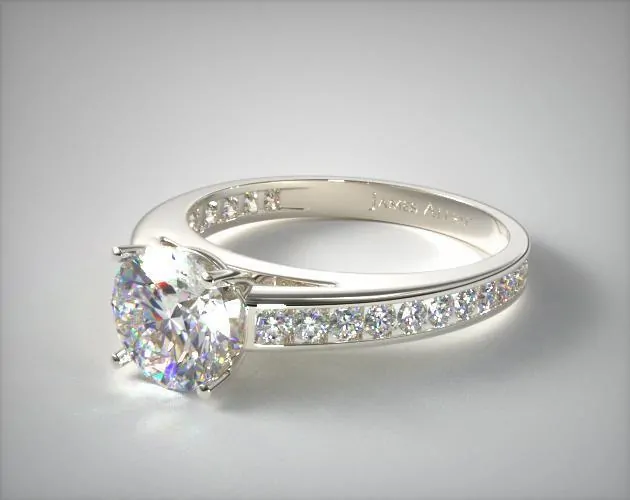
What We Like About It
- The smaller diamonds are protected from rough exposure
- Classic and timeless design
- Small diamonds are more affordable
- Heightens the brilliance of the ring and enhances sparkle all around the band
- Does not commonly catch on objects
What We Don’t Like
- Cleaning the stones will be tricky as dirt can get lodged within the grooves of the channel
- Resizing will prove difficult, if not impossible
- Diamonds can get dislodged over time
9- The Pave Setting
Pronounced ‘pavei’ after the French word for ‘paved’, this setting features tiny diamonds set on the band close together to create a ‘paved’ look. The stones are attached into tiny holes drilled into the band and are kept in place by minute metal droplets that serve as little prongs. Pave settings complement a bigger diamond center piece and the tiny closely-knit diamonds themselves exude an interesting and unique appeal.
The disadvantage, however, of this setting is that some of the tiny stones may loosen up over time and may get dislodged from their holes. Resizing can be hard too when the security of the stones highly depend on them being held tightly in their place.
Pave settings are simply gorgeous to look at and great for a dramatic, eye-catching ring. They sparkle with intensity from all angles due to the light reflecting off all the little diamonds.
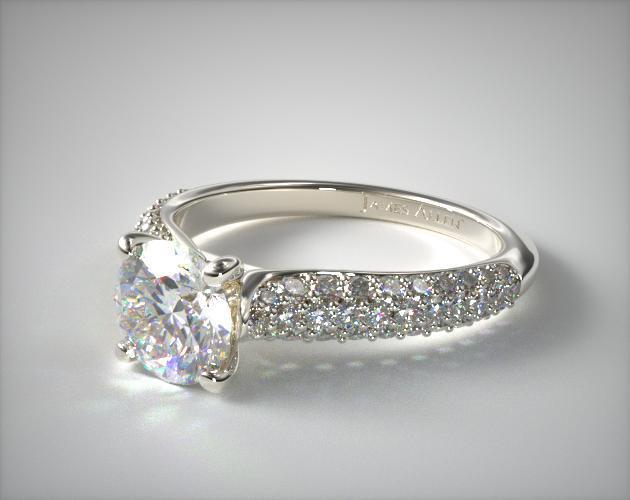
What We Like About It
- Focuses on the center gemstone and shows it to advantage
- Ideal for less brilliant center gemstones
- The ring exhibits brilliance from all angles due to the tiny diamonds
What We Don’t Like
- Cleaning requires more time and effort due to the grooves around the little diamonds
- Resizing is difficult, especially if the pave goes around the entire band
- Some possibility of small diamonds falling out over time
10- The Flush Setting
Also called the ‘gypsy setting’, here the stones are nested perfectly or flushed into the metal of the ring. The type of stones you wish to have are totally up to you. Generally, it is difficult to have a very large stone flushed into the ring, so smaller stones are a better choice for this setting.
The security that the flush setting offers make it the best option for people who lead active lifestyles but the setup of the stones decrease their visibility and affect the overall brilliance of the diamonds.
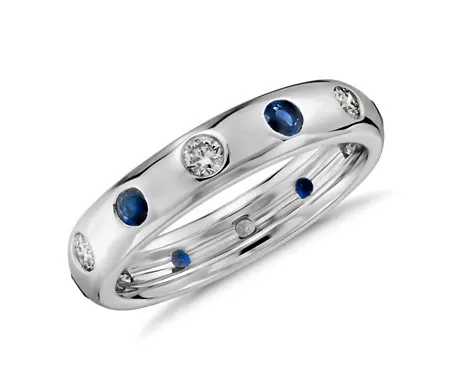
What We Like About It
- Provides the highest security for gemstones
- Ideal for people leading an active lifestyle and those with busy hands
- Very practical and functional to wear
- Easy to clean and maintain
What We Don’t Like
- Less visibility of the stones
- Decreased sparkle and brilliance as there is little light reflection
- More emphasis on the band rather than on the stones
11- Bar Setting
This setting is somewhat similar to the channel setting in that the stones are lined up in a row. However, rather than there being a groove for the diamonds to be placed within, the stones are secured by a metal bar between them. This makes for an eye-catching and unique design.
The bar setting is a popular choice for wedding rings, but for a typical engagement ring look, you can opt to have a center gemstone.
It is quite a unique choice and is very eye-catching. The bar setting is not a common choice, so you won’t find it at most retailers.
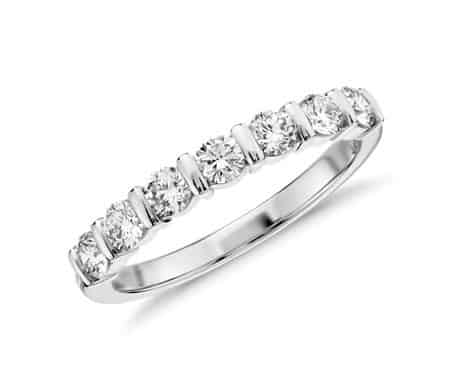
What We Like About It
- A unique and eye-catching design
- Allows for more light reflection meaning higher degree of brilliance from the little diamonds
- Easier to clean than channel settings
What We Don’t Like
- Slightly less secure than channel settings
- Greater possibility of diamonds falling out due to impact
- Resizing is difficult and can be costly
12- Vintage and Antique Settings
Vintage designs are highly in demand, as designers reimagine antique styles for the 21st century, giving them a modern appearance with a twist of the past. Most common vintage setting styles are Victorian, Edwardian, Art Nouveau and Georgian era styles.
The antique appearance of vintage rings, usually achieved by delicate engravings, sophisticated bead details and fine filigree work, is ideal for someone who appreciates art and culture. They tend to look imposing and elaborate, ideal as heirloom pieces to be passed on from one generation to the next.
If you are choosing an actual antique ring (as opposed to a newly made ring of antique design) ensure that the ring has been checked by a jeweler for integrity and authenticity.
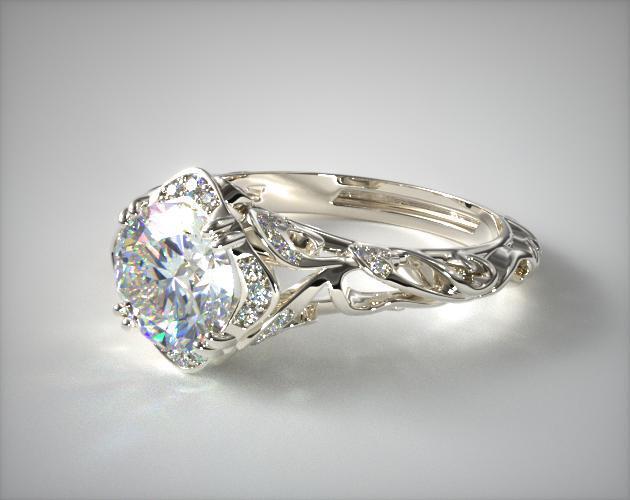
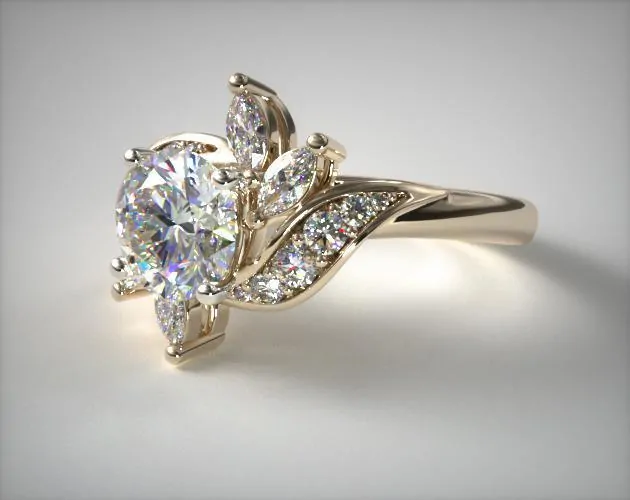
What We Like About It
- Designs can be sophisticated and stunning, with meticulous detailed work
- Ideal for people who want a more dramatic ring
- Each ring is unique and has its own ‘personality’
- Choose from a time period with distinct designs and styles
What We Don’t Like
- Cleaning and maintaining may prove difficult due to elaborate designs which may have grooves, crevices and other hard to reach areas
- Can be more expensive
13- The Three Stone Ring
This meaningful style features three diamonds side by side, usually held with prongs. The diamonds can be in similar sizes or you can choose to emphasize the center stone by opting for a large center gemstone flanked by two smaller ones.
With a three stone ring, you can play with the price of the diamond, as choosing smaller diamonds will naturally be less expensive compared to the bigger diamonds needed for the solitaire style.
The three stone ring style is contemporary, fashionable and cost-efficient at the same time. An added plus to this style is the meaning that each stone brings. The three gemstones represent different time periods of your relationship: your past, your present and your future, symbolizing the eternity of your relationship. Wouldn’t that captivate the heart of your beloved!
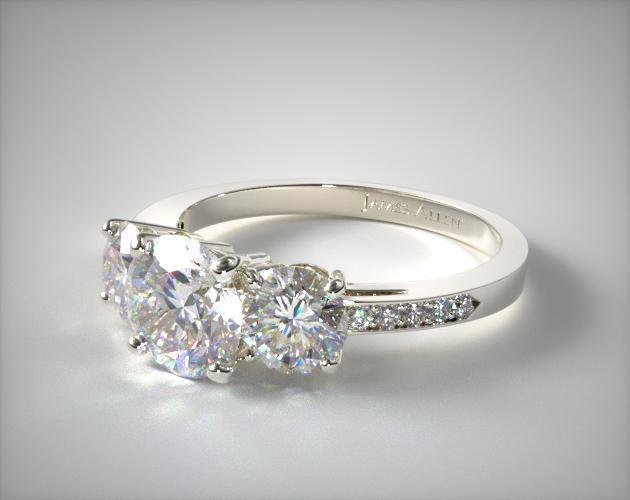
What We Like About It
- Designs can be sophisticated and stunning
- Provides better coverage for wider fingers
- You can choose different gemstones for greater contrast in the design
- Smaller diamonds and gemstones are often more affordable than one large solitaire diamond
- There are many variations to the linear 3-stone setting, allowing for more customization
What We Don’t Like
- More crevices and hard to reach areas may make cleaning difficult
- Over time prongs may wear thin and diamonds may become loose or dislodge
14- The Split Shank
The split shank style features a shank that splits into two as it approaches the center stone. The shank refers to the body of the ring which is worn around the finger. Some interpret this to mean that a healthy personal space in a relationship contributes highly to the strength of the love shared between the couple.
Figurative words aside, the split-shank is ideal if you want more decorative details to be added to the shank, say smaller diamonds or an interesting floral design. Often the shanks are embellished with a channel or pave setting (see example) to add sparkle, texture and dimension to the ring.
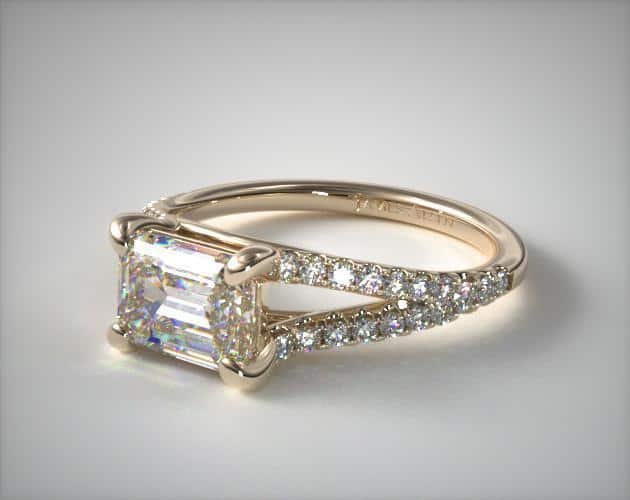
What We Like About It
- The design is unique, eye-catching and stunning
- Makes the center stone the focal point of the ring
- Additional brilliance and sparkle if the shanks are set with stones
What We Don’t Like
- Can be more difficult to clean and maintain compared to simpler settings
15- Double Shank Setting
The double shank may look very similar to the split shank but take a closer look and you’ll notice that there are indeed two shanks, not one.
With the double shank design, the ring consists of two metal bands that split as they come towards the center stone. Double shank rings are more elaborate and flashy, and have a stylish and glamorous feel. In essence, it is like having two rings in one.
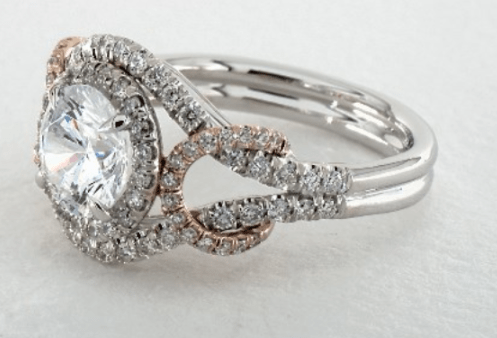
What We Like About It
- Offers an elaborate and dramatic design
- There is more area for added embellishments and stones
- High brilliance and sparkle
- Accentuates the beauty of the center stone
What We Don’t Like
- Requires more cleaning and maintenance than most other settings
- Can have a heavy appearance and may not be suitable for short or slender fingers
16- East-west Setting
We’re used to seeing things a certain way, and the slightest tweak can make us sit up and take notice. An east-west setting is so called because the center gemstone is set horizontally rather than vertically on the setting.
Vertically set gemstones is the go-to style for gemstones that aren’t perfectly round or square, but the east-west setting provides a non-traditional option. This is an uncommon setting and is currently increasing in popularity.
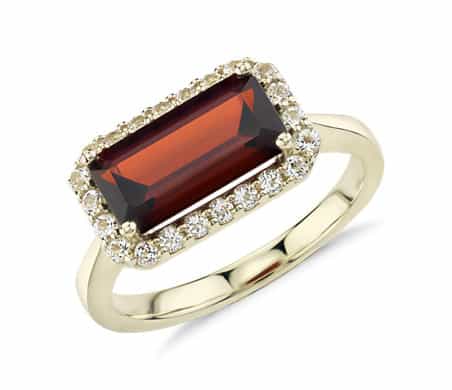
What We Like About It
- Eye-catching and unique
- Great for people who want an alternative to traditional rings
- Highly popular and a trending ring style
What We Don’t Like
- Generally doesn’t complement short or wide fingers
17- Invisible Setting
The invisible setting was first created in France. It is so called because you cannot see what holds the stones in place as there are neither prongs nor bezels. Instead, what keeps the stones securely in place is a metal construction hidden beneath them.
In order to ensure that the stones are protected from falling off, this construction is inserted into the stones through grooves made in the stones. All these are behind the scenes and what we actually see is a set of stones seemingly held in place by nothing. If you don’t look closely, it appears like one large stone, as the grooves can be difficult to see.
Generally, the stones in an invisible setting are secure although it greatly depends on the quality of work done by the jeweler. However, with this type of setting, the stones are less visible as they are commonly set flush against the metal, thereby affecting how they can play with the light.
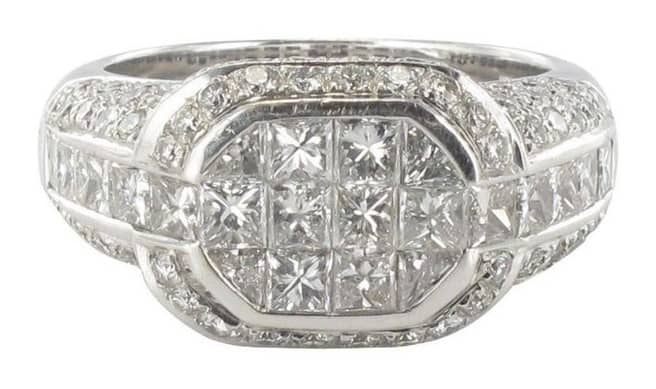
What We Like About It
- Attention-grabbing and unique
- You can use smaller gemstones to create the illusion of one large stone
- There is added texture in the design of the stones
- Easy to maintain
- Stones are held securely in place
What We Don’t Like
- Sparkle is reduced as the gemstones are set very low on the band
- The value of the stones is compromised due to the drilling of grooves into them
Where to Shop
Beauty and security are the two main factors that will influence your decision when choosing your engagement ring setting, but as you might have noticed after going through all the settings above, there’s usually a trade-off between the two. It will be important to find that happy point of equilibrium that works best for your stone of choice.
We recommend James Allen as they are the best in online shopping for engagement rings. They have a great range of settings at reasonable prices.
For engagement rings at great prices explore Blue Nile.
You can also build your own ring by playing around with setting and gemstone combinations on both Leibish and James Allen.
To re-cap see this infographic on all you need to know about different settings and styles of engagement rings










